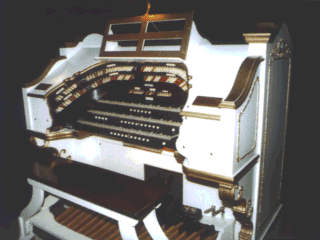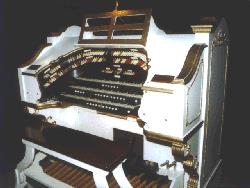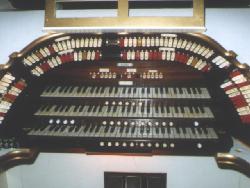
A Chapter of the American Theatre Organ Society
The Western Reserve Theatre Organ Society, founded in 1962 as a chapter of the American Theatre Organ Society, is a non-profit educational corporation dedicated to furthering the use and understanding of the Theatre Pipe Organ and its music.

Membership
Membership in the WRTOS is open to persons of all ages who have an appreciation for organ music- especially Theatre Pipe Organ Music.
All chapter members and their immediate families have open console privileges (the opportunity to play real theatre pipe organs) at our meetings and at the Grays Armory 3/17 WurliTzer. Monthly meetings are held at public facilities and private residences- mostly local- where operating pipe organs are installed. Our periodical newsletter, "The Relay" keeps members informed of current events and concerts in our area. Members joining ATOS at the national level also receive the acclaimed bi-monthly journal, "Theatre Organ", containing articles of interest to the theatre organ oriented listener, historian, technician and audiophile.
You don't have to be a musician, own an organ, or have any skills to join WRTOS. Many members come just to listen! Others learn how to play, rebuild or restore these magnificent instruments. Don't be misled by our rather auspicious sounding title- we are first and foremost a group of people intent on having fun with a common hobby. while we welcome all the help we can get, no chapter member is obligated to assist in organ restoration, concert production or any other phase of chapter operation. All work is done on a volunteer basis.
We especially encourage youngsters studying organ to join us. There is much to be done teaching the artistry and restoration of these instruments. Youth must be trained to take over as our senior members retire. Join us, won't you?
Education: Our Main Goal
Artistic Education: the highlight of our activities is our annual concert series at historic Grays Armory in downtown Cleveland. National and international artists have been featured in public concerts since 1970. Private (members only) concerts and open console sessions at other public and private facilities allow hands-on experience and the development of desired skills.
Technical Education: Since virtually no theatre pipe organs have been built in 65 years, the crafts involved are almost completely lost. Restoring, rebuilding, and reinstalling theatre pipe organs in suitable locations provides a challenging labor of love and develops skills ranging from correct engineering and layout to artistic pipe voicing and tuning.
WRTOS pursues this ambitious campaign of education because we believe the Theatre Pipe Organ is a glorious national treasure and a lively art form that can continue only as long as these great organs can produce their inimitable sounds in the hands of competent artists. To that end we are striving to preserve, protect, and restore organs in operating theatres and auditoriums so that they may be enjoyed by large numbers of people in the surroundings for which they were built.


On Dec. 8, 1892, fire destroyed the City Armory located on Long Street. Long Street was later vacated for the Cleveland Union Terminals project. The City Armory had been shared by several independent military units. After the fire, two of the units set out to construct their own armories. In May 1893, the Cleveland Grays laid the cornerstone for their own armory at 1234 Bolivar Road.
In addition to serving the Grays for military functions, the armory has always served the community as a social center. The Grays Armory hosted such events as military balls, events for Cleveland's 1896 centennial, the Metropolitan Opera, Cleveland's first auto show on Feb. 1, 1903, John Philip Sousa, and the Cleveland Orchestra. In fact, a plaque outside the drill hall notes that in this building the Cleveland Orchestra presented its first concert on Dec. 11, 1918. Regular minstrel shows were held there too. In the front lobby of the building the original ticket booth still stands.
For the most part, the building remains as originally built both on the exterior and in the interior. The elegant main lobby is first seen by the visitor. Red carpeting and Persian rugs complement the dark woodwork and decorative cornices.
Over the years, the Grays have served as a unit in the Civil War, the Spanish American War, and the First World War. From the Second World War on, the Grays have served as individuals, joining U.S. armed forces, rather than as an independent military unit.
Typically, independent military companies were formed at times of threat. It is unclear, however, what prompted the formation of the Grays, as no records indicate Cleveland was under any real threat in 1837. Their purpose was twofold: one to build up the regular army's strength; the other to be the local militia, ready to provide assistance in the event of trouble of any sort. With this in mind, the 118 founding members adopted "Semper Paratus" ("Always Prepared") as their motto.
The first members were all veterans of earlier military campaigns such as the Revolutionary War and the War of 1812. Independent military companies like the Grays were fundamentally important because there were hardly enough regular or federal troops to protect all of the states and localities.
During the Civil War, independent units were a major resource of troops for both the North and the South. In the Cleveland area, the Grays were the first to answer the call for troops by President Lincoln in 1861.
Under the current leadership of George N. Vourlojianis, the Grays have expanded their civic contribution to include the preservation and promotion of military history. Memorabilia, artifacts and documents acquired over the years are being identified, indexed, and catalogued. Throughout the armory are swords, guns and uniforms - a cannon sits in the lobby! The walls are covered with photographs and renderings.
 OR
OR 
The Armory Wurlitzer - Specifications SOLO Tuba Profunda 16' Diaphone 16' Tibia Clausa 16' Trumpet 8' Harmonic Tuba 8' English Post Horn 8' Diaphonic Diapason 8' Tibia Clausa 8' Clarinet 8' Kinura 8' Orchestral Oboe 8' Quintadena 8' Salicional 8' Harmonic Clarion 4' Octave 4' Piccolo 4' Chimes Xylophone Glockenspiel Bells Reiteration GREAT Tuba Profunda 16' Diaphone 16' Tibia Clausa 16' Clarinet 16T Bourdon 16' Vox Humana 16TC Trumpet 8' Harmonic Tuba 8' Diaphonic Diapason 8' Horn Diapason 8' Tibia Clausa 8' Clarinet 8' Kinura 81 Orchestral Oboe 8' Viol d' Orchestra 8' Viol Celeste 8' Salicional 8' Concert Flute 8' Vox Humana 8' Harmonic Clarion 4' Octave 4' Piccolo 4' Viol 4' Octave Celeste 4' Salicional 4' Flute 4' Twelfth (Tibia) 2 2/3 Twelfth 2 2 Piccolo (Tibia) 2' Fifteenth 2' Piccolo (Tibia) 2' Tierce 1 3/5' Marimba Harp Chimes Sleigh Bells Xylophone Glockenspiel Bells Reiteration Chrysoglott Solo to Great Piano 16' Piano 8, Piano 4' ACCOMPANIMENT Contra Viol 16TC Bourdon 16' Vox Humana 16TC Harmonic Tuba 8' Diaphonic Diapason 8' Horn Diapason 8' Tibia Clausa 8' Clarinet 8' Kinura 8' Orchestral Oboe 8' Quintadena 8' Viol d' Orchestra 8' Viol Celeste 8' Salicional 8' Flute 8' Vox Humana 8' Octave 4' Piccolo 4' Viol 4' Octave Celeste 4' Salicional 4' Flute 4' Vox Humana 4' Twelfth 2 2/3' Piccolo 2' Marimba Harp Chrysoglott Snare Drum Tambourine Castanets Chinese Block Tom Tom Sand Block Solo to Accomp. PEDAL Diaphone 32' Ophicleide 16' Tuba Profunda 16' Diaphone 16' Tibia 16' Bourdon 16' Viol 16' Harmonic Tuba 8' Diaphonic Diapason 8' Tibia Clausa 8' Clarinet 8' Cello 8' Concert Flute 8' Octave 4' Great to Pedal Bass Drum Kettle Drum Crash Cymbal Cymbal Piano 16' ACCOMP. 2nd TOUCH Harmonic Tuba 8' Tibia Clausa 8' Clarinet 8' Chimes Xylophone Sleigh Bells Triangle Solo to Accomp. GREAT 2nd TOUCH Tuba Profunda 16' Tibia Clausa 8' Clarinet 8, Solo to Great TREMULANTS Main Solo Vox Humana Tuba Tibia Clausa Effects: Bell Auto Horn Horses' Hooves Bird Whistle Wooden Block Surf Gong Steam Whistle Crash Cymbal Misc: Piano : Rinky-Tink On/Off Harp 1: On/Off Harp 2: On/Off Piano Damper Solo Swell Shoe Main Swell Shoe Crescendo Shoe
Sponsored by: